In the hot and humid dog days of summer, most anglers do not associate this weather pattern with topwater frog fishing. While topwater lures can be extremely effective in the early morning and nights of those hot summer days, LM bass just don’t want to exert the energy on a fast-moving topwater lure during the peek of the day. Can you really blame them? There is however an extremely effective and fun way to catch fish in this almost unbearable time of year. This technique, my friends, is topwater frog fishing.
My fishing days began just before I was 3 years old, and ever since I can remember I have always loved the looks of topwater frogs. Since then I have learned not only do they look cool, but they catch fish too. While I do not know on a scientific level if bass prefer frogs over other forage, I do know they strike them and eat them. This makes for some of the best summer action possible when the weather is steaming. And if you are like me, and cannot put your fishing pole down regardless of the temperature, this fishing technique may be for you.
Types:
There are two main types of topwater frogs on the market; a hollow plastic topwater frog and a soft plastic buzz/swimming frog. There are many variations and manufacturers of these lures and all have their benefits. Hollow plastic topwater frogs are ideal for fishing extremely slow, while the soft plastic buzz frogs are better for quicker retrieves, but both types can be fished fast or slow. These frogs remain on the surface at all times, while soft plastic frogs typically sink slowly like most soft plastics, some, however, are made of a floating plastic which keeps it on top at all times.
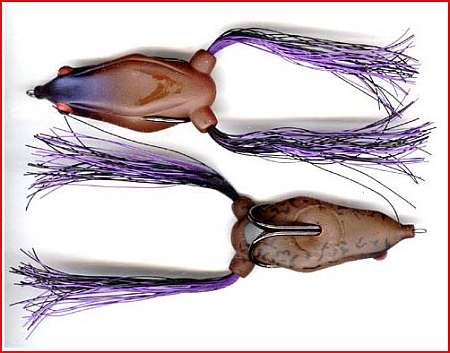
Hollow plastic frogs are typically outfitted with a heavy double hook already in the body. Buzz frogs, on the other hand, are just like any other soft plastic bait, and you will need to attach the hook yourself, generally in a Texas-rigged manor. Buzz frogs are a very bulky soft plastic bait and the use of an EWG (extra wide gap) hook is necessary. One of the best features of these baits is their weedless design.
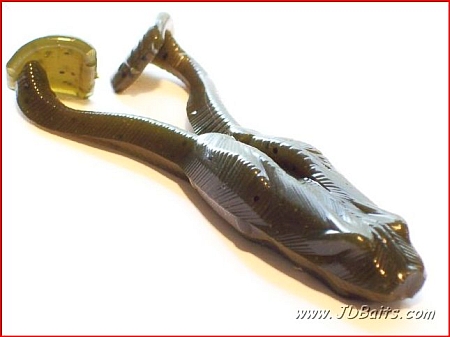
Advantages:
The main advantage of topwater frogs is that they are extremely weedless. As just about any fisherman knows, no lure is truly weedless. It is pretty much impossible to make a lure that is completely weedless that actually has hooks on it. With that being said, these baits, can be thrown into the thickest, sloppiest jungle and still be retrieved when using the correct tackle and technique.
Another main advantage of these lures is their natural look. In all my fishing I try to keep my lures as natural looking as possible, feeling that the fish sees what I see. In this respect, I mean that the color of the natural forage is the color I will be trying to mimic because no matter the water clarity and light penetration fish are still eating the natural forage. This being said, color choices do not always reflect this though, because obviously, a fish cannot eat the bait if it cannot find it through vision or vibration, so unnatural colors also produce fish. Both styles of frogs are produced in tons of colors ranging from exact replicas of frogs to ones looking like a tropical tree frog, or something that lives near a nuclear power plant.
With all these color choices, I do not feel that color is all that important with these baits, although, I tend to stick more toward the natural colors than the flashy colored baits. Not only are the color choices natural, but the shapes of these baits are extremely lifelike. The general shape of the body creates an extremely natural silhouette that the fish key into. The legs of these baits range from a rubber skirt type material to molded rubber that closely mimics real frog legs.
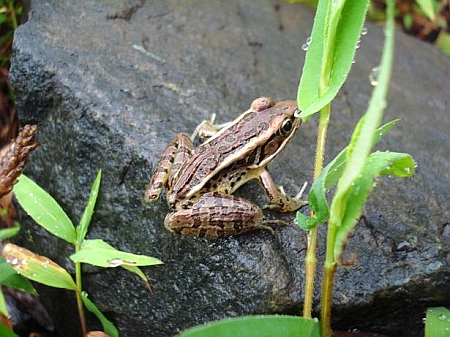
A third advantage of these baits is their versatility. As said before, both frog types can be fished fast or slow. The hollow baits shine with extremely slow presentations since they float. Buzz frog hold their own though. They can not only be fished on top but can be fished throughout the entire water column.
Tackle, Equipment, and Rigging:
Tackle is one of the most important aspects of this type of fishing. In most cases, these lures are most deadly when fished in and around extremely heavy vegetation. Whether it is matted floating grass or a solid mat of lily pads, you need to use tough enough tackle to haul the fish out of the slop.
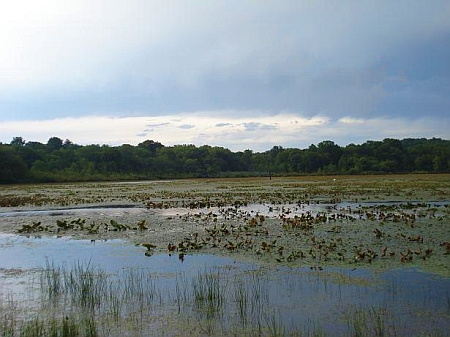
The most important piece of tackle is your fishing line. After years of experimenting with different types and strengths of lines, I have concluded that braided line is the best line for Topwater Frog Fishing. My choice is nothing less than 20lb braid. I have however found a few advantages of using a heavy mono line. Before using braid I used 20lb mono for a long time. The stiffness of the heavy mono allows you to guide the line through the thick cover and it does not fall beneath and entangle itself in overhanging lilies like limp braid. Another advantage of heavy mono is the stretch that it gives. This stretch can be helpful because as with just about all topwater fishing, you should not set the hook instantaneously to allow the fish to get the bait fully in its mouth.
These few advantages do not, however, outweigh the many advantages of a braided line. Braid allows one to have complete confidence in getting your lure back from the jungle you threw it in. Not only does it give you this confidence, but it can cut through grass and improve your casting distances over heavy mono significantly. The knot strength of braided line is also incredible, making it a perfect choice when you have a 5lber on with another 5lbs of weeds on the end of your line.
With the line choice taken care of, you now need a rod and reel. My preference for this type of fishing is definitely a heavy baitcasting outfit. While a heavy spinning outfit can be used, baitcasting offers many more advantages. A high-speed baitcasting reel matched with a medium to heavy power rod, 6’6” and longer is ideal. Spinning tackle just does not offer the strength of a baitcasting outfit. Many rod manufacturers produce a “Frog Rod” which in most cases is over 7’ long, with medium-heavy to heavy power, and a fast to extra-fast action.
Having an extra-fast action with a lot of backbone allows you to cast light hollow frogs and still be able to horse a lunker to the top of the slop and haul it in. A longer rod also allows you to guide the bait through an aquatic jungle and keep the line out from under overhanging vegetation. Even though a baitcasting setup is ideal, I have seen many die-hard spinning anglers successfully fish these baits. The main thing in this technique is a tough line and that you are comfortable and confident with the setup.
Since hollow plastic topwater frogs already come rigged with a hook, the only thing left to do is tie it on with a strong knot. I prefer a Palomar knot over any other knot due to its ease of tying and strength. As many know braid can sometimes pull itself free, but a Palomar knot seems to be the best knot to use to prevent this. If you are not confident in your knot tying ability, a shot of super glue or fishing glue can give you that confidence.
Soft Plastic buzz/swimming frogs do not come pre-rigged, but they are as simple as any other soft plastic to rig. Although there are hooks specifically made for buzz frogs, I prefer an EWG Gamakatsu superline hook in a size ranging from 3/0 to 5/0 for most frogs. Obviously choosing a hook size will be determined on the size of the bait. As said before, these are very bulky soft plastic baits and an EWG hook is necessary. To rig these frogs, just Texas-rig them like any other soft plastic. The specialty frog hooks have a corkscrew attachment on the eye of the hook that screws into the nose of the frog, then you just bury the hook into the back of the bait as if you were finishing up a t-rig. As with hollow plastic topwater frogs, a Palomar knot is about the best you can do.
Technique:
Now that you are rigged and ready to go, it is now time to learn how to fish these bad boys. Topwater frogs are not only effective in the hot days of summer but can be effective as soon as frogs come out of their dormant period. While the main thing to look for before using these baits is a good population of frogs in the body of water. I have also caught fish in lakes where I have only seen a frog here and there, but it definitely helps when there are many frogs in the body of water.
The best advice I can give for fishing these baits is to watch what fish are reacting to, as with any other type of lure. If I see frogs going wild, doing their mating rituals, or whatever they do on the top of lily pad mats, I will generally try to mimic the movements of the real frogs.
When beginning to fish frogs for the day, I generally start by fishing the weed edges and pockets in the weeds, trying to target the active fish that are positioned on ambush points. When starting out I tend to fish slow, speeding up the retrieve by small increments on every cast. Slow meaning let the frog sit for up to a minute or more, give it a twitch, let it sit, and repeat.
When I say fish it fast, I mean never stop reeling and twitching your rod to make a swimming action. After fishing the more open water I gradually move to the thickest of the thick areas. Most people think I am crazy casting on top of a solid mat of pads or matted grass, but I don’t care, most people think I am crazy anyway. There is nothing quite like seeing a bass bust through a mat of vegetation that looks like you could walk across it.
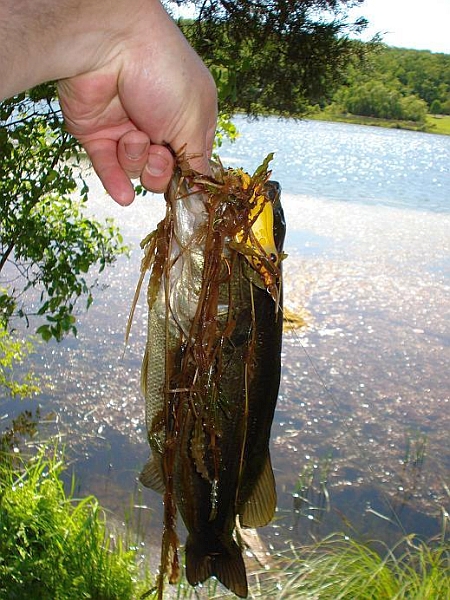
Both types of topwater frogs have specific techniques to fish them. I generally opt for a buzz frog for more sparse vegetation and go with a hollow plastic frog when fishing the jungles, but this is not always the case, let the fish tell you what type of action they want on a given day.
In most cases, buzz frogs are fished much faster than a hollow plastic frog, but this is not always the case. Soft plastic buzz frogs have a variety of different leg designs that create generally the same actions. These baits can be fished similar to a buzzbait, with a constant reeling motion, or similar to prop baits with a ripping action, or with a dying action that allows the bait to sink, and then jerked back to the top. These baits are extremely lifelike and can be fished from top to bottom in a much slower dying action, which can be deadly when fish are not interested in pure topwater bait.
Frog-type baits creates a very similar action to a buzzbait, but have a more natural silhouette and, in my opinion, have a much better hook up ratio. Although they create a very similar action of a buzzbait when fished fast, they can also be thrown on top of vegetation mats as would be done with a hollow plastic frog. While I could go on for hours discussing different ways to fish these incredible baits, I think it is best to not give too many guidelines and let you experiment on your own, because there are no set rules in fishing and the preferred presentation can vary from day to day or hour by hour.
Hollow plastic frogs have been around for decades and have put countless lunkers in the boat, but many anglers still blow them off as gimmick baits, but this is ridiculous. These baits can be absolutely deadly and almost always produce the biggest fish of the day. The new age topwater frogs are as lifelike as it gets and comes with the sharpest hooks available, making them a great choice in a frog-infested lake.
To fish these creatures, I start the same way as I do with buzz frogs, starting slow then working too fast retrieves, first working the outside edges of vegetation then working them into the thickest of the thick. When casting these baits, I seldom worry about making a big splash, especially when working super thick mats. The splash of the bait attracts the fish and its big silhouette can be seen through the mats against the bright sun. To work these baits, it is pretty much self-explanatory.
Try to make my bait look like real frogs messing around on top of vegetation mats or swimming around weed edges, slight twitches to aggressive walk-the-dog actions can be effective. The most important thing to do when fishing these baits is to watch and remember what presentations the fish are reacting to. Other than watching the fish, be systematic in your approach, otherwise, you will have no idea how to catch a second fish or get that second strike after a miss.
This past year I have started twitching frogs in the same spot, jiggling the rod so that there is movement, but the lure is maintaining the same position. This technique is very deadly when a fish misses the bait the first time. I will cast back to the same spot and make the frog vibrate in a spot, causing the fish to believe they wounded the frog, which they cannot resist biting. The fish will clue you in on what they want that day. As said before about buzz frogs, I could go on for hours about presentations, but experimentation and observation with these baits are better than any advice I could give.
As with many other types of bass lures, one of the most important things to keep in mind is to make multiple casts to the same area with different presentations. Also, if a fish missed your bait, do not give up. After I miss a fish or the fish misses my bait, I will make up to 5 casts to the same exact spot. If I do not get a hit in those casts I will let the spot rest for 15 to 45 minutes, because I know that fish is still there and will hit, especially if it felt no hooks.
The Hookset:
After figuring out your tackle and bait choices, the next step to this fishing technique is learning the hookset. This can be the most frustrating part of this type of fishing. Both types of frog bait have basically the same two types of hook setting techniques.
The first technique is similar to most topwater baits. This hook setting technique is about the hardest to master in my opinion, and I have yet to completely master it myself. Basically, when the fish strikes you should wait until you feel the fish on your line to set the hook. This can be extremely hard when a fish explodes on a frog but is the most important aspect of this type of fishing, or you will only be setting the hook into the air and your frog comes flying back at you.
My general rule when setting the hook in this manner is to drop the rod tip and quickly reel the slack line while counting 3 to 5 and then give it an atomic Bill Dance hookset. This technique is not always possible because when fishing very heavy matted vegetation the fish does not always get the bait in its mouth and actually launches the bait into the air.
When this happens, most of the time there will be a hole in the matted vegetation where the fish launched at the bait. This created hole now gives you a great advantage. It allows you to know exactly where the fish was hiding and provides open water for a much more solid bite and hookset. If the fish refuses to hit the bait again within 3 to 5 casts, my best advice is to let the spot rest for 15 to 45 minutes.
My second hook setting technique is far easier to learn because it is basically an automatic reaction to a strike. This technique only works when the fish bites the bait very solid. Basically, as soon as the fish hits, keep your rod high and maintain tension with the line by quickly reeling or by lifting your rod higher, then hope and pray that the fish has it in their mouth and your hooks are extremely sharp.
This technique works best in more open water, especially when the fish just sucks the frog from the surface rather than exploding on it. This is also my main hook setting technique when using soft plastic buzz frogs since the bait is mainly moving faster than a hollow plastic frog and is generally in more sparse cover. While both techniques work at their given time, on a long cast, setting the hook quickly will often be your best bet. A strike at the end of a long cast should be set quickly because the added line you must pick up gives you an automatic delayed reaction to the strike.
The best technique is to find the extremely aggressive fish that set the hook themselves. While this is not normal, it does happen more often than you would expect. The best way to prepare for this is keeping your hooks very sharp, otherwise, you have a slim chance of an auto-hookset.
Setting the hook with these types of lures, especially hollow plastic frogs, can be extremely frustrating. Try to keep your cool and not let it get to you. I know this sounds ridiculous, but fishing is fishing, you can’t always get what you want. My best advice to keeping your cool is to mumble profanity under your breath or, if no one is around, scream it as loud as you can. If profanity is not for you, maybe take a few deep breaths. This will help you get your frustrations out without the guilt of profanity. I definitely do not advise anyone to smack their rod tip into the water, against the boat, or into rocks, like some of my friends.
The most important thing to remember is to never let the fish get the best of you. Missing fish with this technique is expected, and it is a given that bass will strike every time you are not ready or not paying attention. The two best examples of this are 1. After picking out a backlash for over 5 minutes, I finally twitched my sumo frog and the biggest bass of my life exploded on the bait after over 5 minutes of backlash frustration. I then proceeded to miss this fish, cast back and miss it again….I almost had an aneurysm. 2. While talking to a fellow angler about topwater frogs, he asked me if I ever caught anything on them, as soon as I said “yeah, but I miss more than I catch” a bass exploded through a pad mat and I launched the bait back at my head.
The best advice I can give for setting the hook on these baits is just to have patience. Realize that these baits have one of the lowest hooking percentages of any bait and missing fish is very common with these lures. The only thing that will get you coming back is that crazy strike with a lunker on the end of your line.
Good Luck with Topwater Frog Fishing and let the pads grow!
–Jake
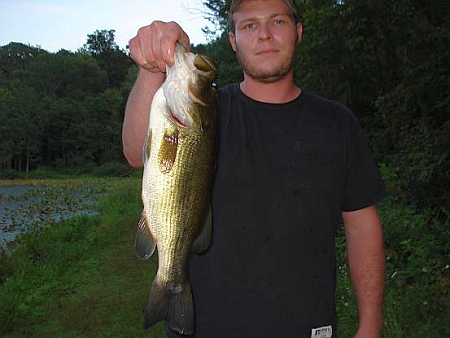
Touche. Great arguments. Keep up the amazing effort.